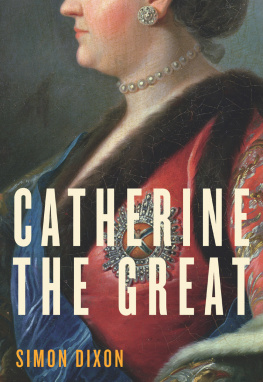Empress of Russia Catherine II - Catherine the Great
Here you can read online Empress of Russia Catherine II - Catherine the Great full text of the book (entire story) in english for free. Download pdf and epub, get meaning, cover and reviews about this ebook. City: Russia;Russia (Federation, year: 2015;2010, publisher: Ecco;Routledge, genre: Non-fiction. Description of the work, (preface) as well as reviews are available. Best literature library LitArk.com created for fans of good reading and offers a wide selection of genres:
Romance novel
Science fiction
Adventure
Detective
Science
History
Home and family
Prose
Art
Politics
Computer
Non-fiction
Religion
Business
Children
Humor
Choose a favorite category and find really read worthwhile books. Enjoy immersion in the world of imagination, feel the emotions of the characters or learn something new for yourself, make an fascinating discovery.
- Book:Catherine the Great
- Author:
- Publisher:Ecco;Routledge
- Genre:
- Year:2015;2010
- City:Russia;Russia (Federation
- Rating:3 / 5
- Favourites:Add to favourites
- Your mark:
Catherine the Great: summary, description and annotation
We offer to read an annotation, description, summary or preface (depends on what the author of the book "Catherine the Great" wrote himself). If you haven't found the necessary information about the book — write in the comments, we will try to find it.
Catherine II of Russia (172996) might have been forgotten as a German-born Romanov brood mare but for her unscrupulous seizure of the Russian throne in 1762 and subsequent lengthy reign as the quintessential Enlightenment monarchachievements that have fascinated posterity ever since. For her remarkable story, British historian Dixon, steeped in Catherines setting, positions his work between the scholarly and the salacious and accents courtier politics and the autocrats sensibilities. After recounting the palace coup that brought Catherine to power, Dixon develops her approach to wielding it through her interactions with builders, diplomats, generals, lackeys, and pen pals, such as Voltaire, on the receiving end of her reforming zeal. With the building boom in St. Petersburg, constitutional changes, and territorial expansion that accompanied her reign as backdrops to his portrait, Dixon sympathetically educes Catherines personal life; that is, the train of swains caught up in heras one chapter title puts itsearch for emotional stability. An appreciation of the person Catherine the Great that is full of insightful perceptions. --Gilbert Taylor
ReviewThere is lots new in this superb biography . . . [Dixon] manages to be scholarly, refreshing, commonsensical and compelling, vividly portraying the charismatic Empress and her times. (Simon Sebag Montefiore, author of Sashenka and Young Stalin )
Like Catherine herself, Simon Dixons new biography is attractive, engaging, and very intelligent. It wears its scholarship lightly, too, but established fans of the Russian empress will find plenty of new material and those who are meeting her for the first time will be dazzled. (Catherine Merridale, author of Ivans War and Night of Stone: Death and Memory in Russia )
Empress of Russia Catherine II: author's other books
Who wrote Catherine the Great? Find out the surname, the name of the author of the book and a list of all author's works by series.






















